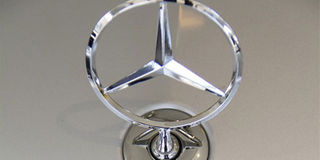Drivers to take back seat as cars go on self-drive

A Mercedes logo on a car at the DT Dobie Showroom, College House, Koinange Street. Photo/FILE
What you need to know:
- The autonomous autos could greatly reduce the number of accidents and give makers
- The Mercedes is able to brake and accelerate by itself on the highway or in stop-and-go traffic
- Luxury carmakers like BMW and Audi are working on their own autonomous systems
FRANKFURT, Germany
A wide grin beneath his bushy mustache, Dieter Zetsche, the chief executive of Daimler, did as car executives often do at auto shows, cruising on to the stage in the company’s newest model.
But at the Frankfurt motor show last week, Zetsche added a surprise: He sprang from the back of a Mercedes S-Class that had no one in the driver’s seat. Cars that drive themselves have been a science fiction dream for decades, but at the Frankfurt show, there was a palpable sense that the technology was moving quickly from laboratories and test vehicles to dealer showrooms.
If the visionaries have their way, the autonomous autos could greatly reduce the number of accidents and give makers — especially in Europe — something they badly need: A new reason for people to buy cars.
“In 2020, all the problems and challenges we are seeing today in allowing an autonomous driving car will be solved,” Carlos Ghosn, the chief executive of the Renault-Nissan alliance, told reporters at the auto show.
The latest version of the Mercedes S-Class, which goes on sale in the United States next month starting at slightly more than $92,000, is able to brake and accelerate by itself on the highway or in stop-and-go traffic.
And it can steer itself on a straight or lightly curved road. For safety and legal reasons, the driver still needs to keep a hand on the wheel and be ready to cope with more complicated situations.
Luxury carmakers like BMW and Audi are working on their own autonomous systems, which are moving ever closer to vehicles that can do almost all the driving themselves.
While buyers of expensive vehicles will get the technology first, suppliers and midmarket automakers are pushing hard to bring self-driving features to the masses.
“We don’t want to create functions that are only available in super premium autos,” said Christian Senger, head of research for automotive systems at the German auto components maker Continental, which supplies radar sensors and stereo cameras used by the S-Class.
FABULOUS OPPORTUNITY FOR CONVERGENCE
“These people don’t need electronic chauffeurs,” Senger said of luxury car buyers. “They already have humans.”Autonomous driving was one technology trend in Frankfurt that almost all the carmakers seemed to be excited about. Even Chancellor Angela Merkel of Germany, who visited Thursday, hailed what she said was the convergence of digital innovation with traditional German strengths in manufacturing, calling it a “fabulous opportunity.”
Autonomous cars could drastically improve safety. A self-driving car could theoretically allow its owner to continue texting or uploading photos to Facebook. “There is less error in systems than in humans,” said Ghosn. “Computers do not drink or sleep.”
SLIDE IN AUTO SALES
Carmakers also hope that self-driving technology could help arrest an alarming slide in auto sales among younger people. An increasing proportion of young people in developed countries are not bothering to get drivers’ licences, preferring to spend their money on smartphones.
The trend bodes ill for the car industry’s long-term health. Ghosn speculated that governments could even lower the legal age for drivers. His reasoning seems to be that autonomous technology could help compensate for teenage immaturity.
Thomas Weber, head of research and development at Daimler, said he was not worried that young people would lose interest in cars. But he agreed that autonomous driving technology would be a crucial selling point in the future.
However, companies that are bullish on the prospects for electric cars, including BMW and Renault, have introduced new vehicles designed from the beginning to run on battery power.
STRATEGY TO REDUCE INVESTMENT
Other companies, like Daimler, Ford, and Volkswagen, are being more cautious, offering battery-powered versions of existing vehicles.
That strategy reduces the upfront investment because the companies can manufacture the vehicles on the same assembly lines as gasoline or diesel cars.
But some in the industry contend that such conversions will inevitably be inferior, with too much weight and too little battery life, and give electric cars a bad name.
“You have to conceive the car to be electric to maximise the range,” said Jérôme Stoll, head of sales at Renault, which offers two vehicles that run solely on battery power.
Weber said that further advances in autonomous vehicles would require more mobile computer power than is available now, as well as more detailed mapping information and better and cheaper sensors. The quest is pushing car companies closer to technology companies.
In Frankfurt, Continental, which may be best known for tyres but is also a major supplier of automotive electronics, announced a partnership with IBM to develop technology that would allow cars to communicate with one another over a network.
Daimler, which has a lab in Palo Alto, California, is working with Google on several projects, Weber said.
That cooperation may come as a surprise, considering that some German engineers have scoffed at what they consider to be overblown claims by Google that self-driving cars are just around the corner.
Weber said he did not share that scepticism. “I’m quite happy that we have other players in the field,” he said. “It’s not just the stupid old car guys.”





